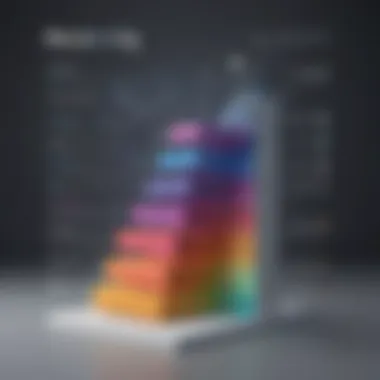Revolutionizing Workflows: A Comprehensive Smartsheet vs. Lucidchart Comparison


Industry Overview
The sphere of productivity and visualization tools is witnessing rapid evolution, with a particular focus on enhancing workflow management and diagramming processes. This sector is highly competitive, driven by the demand for seamless and efficient solutions by professionals across various industries. As technology continues to advance, the need for sophisticated software options like Smartsheet and Lucidchart becomes paramount in ensuring streamlined operations and decision-making.
Top Software Options
In evaluating leading software providers within this domain, two standout names emerge prominently: Smartsheet and Lucidchart. Both platforms offer a plethora of features tailored to optimize workflow management and visualization tasks. Smartsheet excels in project management functionalities, providing robust collaboration tools and Gantt chart capabilities. On the other hand, Lucidchart specializes in creating intricate diagrams and visual representations with ease, enabling users to communicate complex ideas effectively.
Selection Criteria
Choosing the right software solution involves careful consideration of several key factors. Some critical aspects to ponder include the scalability of the platform, compatibility with existing systems, user-friendliness, and pricing structures. Avoiding common mistakes during the selection process, such as overlooking essential features or failing to assess long-term implications, is crucial. Determining the best fit for your business needs requires a balanced approach that aligns software capabilities with organizational requirements.
Implementation Strategies
Implementing software solutions like Smartsheet and Lucidchart necessitates strategic planning and seamless execution. Best practices encompass thorough training of users, integration with current systems and processes, and access to reliable support resources. A successful deployment relies on the effective incorporation of these tools into daily operations, enhancing productivity and optimizing workflow efficiency.
Future Trends
The future trajectory of productivity and visualization tools is poised for further innovation and advancement. Anticipated trends include greater integration capabilities, enhanced data visualization techniques, and the proliferation of artificial intelligence in streamlining workflows. By staying abreast of emerging technologies and adapting to industry shifts, organizations can future-proof their technology stack and maintain a competitive edge in today's rapidly evolving digital landscape.
Introduction
In the realm of workflow optimization, the comparison between productivity and visualization tools plays a pivotal role. Understanding the nuances between Smartsheet and Lucidchart can significantly impact how professionals manage their tasks and data visualization. This detailed analysis aims to provide clarity on the strengths, weaknesses, and overall functionalities of these two powerhouse tools, offering a roadmap for enhancing workflow efficiency.
Overview of Smartsheet and Lucidchart
Understanding the purpose and functionality of Smartsheet
Delving into the essence of Smartsheet reveals a robust platform designed for versatile task and project management. Its key strength lies in its dynamic capabilities to streamline collaboration and integrate with various tools seamlessly. Embracing Smartsheet empowers users with the ability to orchestrate complex projects with efficiency. However, its intricate features may pose a challenge for beginners seeking simplicity in task management.
Exploring the applications of Lucidchart in visualizing data
Lucidchart emerges as a sophisticated tool optimized for visual data representation and diagramming. Its emphasis on clarity and customizable templates elevates data visualization to an art form. The intricate designs possible with Lucidchart make it a preferred choice for userswith a keen eye for aesthetics and detailed project mapping. Despite its visual prowess, the learning curve for utilizing Lucidchart effectively may deter users seeking swift results.
Significance of Choosing the Right Tool
Impact on productivity and collaboration
The chosen tool significantly influences productivity levels by determining how efficiently tasks are managed and communication flows within a team. Opting for a tool like Smartsheet enhances collaboration and accelerates project completion through its interactive features. However, mastering its functionalities may require an initial learning period.
Enhancing project management efficiency


Efficient project management hinges on selecting a tool that aligns with the team's work style and project scope. Tools like Lucidchart offer specific advantages in visual project planning and progress tracking, precisely addressing the needs of project managers seeking clarity in data representation. Nonetheless, its extensive features may overwhelm users unaccustomed to intricate diagramming tools.
Objective of the Comparison
Identifying key differences and similarities
The comparison aims to highlight the distinct attributes of Smartsheet and Lucidchart, emphasizing how each tool caters to unique preferences and work requirements. Identifying the differences and similarities helps users grasp the full spectrum of functionalities offered by these tools to make informed decisions tailored to their workflow needs.
Evaluating which tool suits specific work requirements
Tailoring tool selection to specific work requirements ensures optimal workflow management. Evaluating how Smartsheet and Lucidchart align with distinct project demands enables users to pinpoint the tool that best complements their operational processes. Choosing the right tool is not just about functionality but also about how seamlessly it integrates with existing workflows for enhanced efficiency.
Functionality and Features
Smartsheet Features
Task and Project Management Capabilities
Task and project management capabilities in Smartsheet play a pivotal role in facilitating organized task tracking and streamlined project planning. The robust system allows for efficient allocation of resources, setting priorities, and monitoring project progress in real-time. One key characteristic of Smartsheet's Task and Project Management Capabilities is its user-friendly interface, which simplifies complex project structures, making it a popular choice among professionals seeking enhanced project control and efficiency. The unique feature of automated task dependencies contributes significantly to seamless task management, although for more intricate projects, this feature may have limitations due to its structured nature.
Collaboration Tools and Integrations
When it comes to collaboration, Smartsheet's collaboration tools and integrations shine brightly. These tools enable seamless communication among team members, fostering a conducive environment for project collaboration. The key characteristic of real-time editing and commenting in Smartsheet enhances team productivity by ensuring all stakeholders are updated on project developments instantly. The platform's compatibility with various third-party applications provides users with a wide array of integration options, promoting a more connected and efficient workflow. While this feature offers versatility, some integrations may require additional configuration, impacting overall usability.
Lucidchart Features
Diagramming and Visual Communication Functionalities
Lucidchart's specialization in diagramming and visual communication functionalities sets it apart as a top choice for professionals engaged in data visualization and process mapping. The key characteristic of Lucidchart's intuitive drag-and-drop interface simplifies the creation of complex diagrams, making it a go-to tool for illustrating concepts visually. The unique feature of real-time collaboration enhances team communication and teamwork, ensuring that all members are on the same page during the diagramming process. However, the platform's reliance on internet connectivity may pose challenges in situations where stable internet access is an issue.
Templates and Customization Options
Lucidchart's extensive library of templates and customization options empowers users to create visually appealing diagrams tailored to their specific needs. The key characteristic of pre-designed templates saves time and effort in creating visuals, making it a popular choice among users seeking efficiency in diagram creation. The unique feature of custom templates allows for branding and consistency in visual representations, contributing to a professional look across all communication materials. However, excessive customization may lead to workflow inefficiencies, especially when dealing with tight project deadlines and deliverables.
Use Cases
In this section, we delve deep into the significance of Use Cases within the realm of Smartsheet and Lucidchart. Understanding the specific scenarios where these tools excel is crucial for professionals aiming to streamline their workflow management and visualization processes. By examining real-world applications and practical benefits, we gain valuable insights into how Smartsheet and Lucidchart can be leveraged efficiently. This analysis is essential for decision-makers, IT professionals, and entrepreneurs seeking to optimize their operational efficiency and project outcomes.
Smartsheet Applications
Project Planning and Tracking


Project planning and tracking are foundational aspects crucial for successful project management. Smartsheet's capabilities in this area offer users robust tools for creating detailed project plans, setting milestones, assigning tasks, and monitoring progress. The platform's interactive Gantt charts and customizable templates streamline the planning process, enhancing overall project visibility and task accountability. While Smartsheet excels in providing a comprehensive project overview, its limitations may arise in handling highly complex project structures that require advanced scheduling functionalities.
Resource Management
Efficient resource management is vital for optimizing productivity and ensuring optimal utilization of assets. Smartsheet simplifies resource allocation and monitoring through its intuitive dashboards and collaborative features. Users can easily assign resources, track workloads, and adjust schedules as needed. However, the tool's resource management capabilities may face challenges in scenarios that demand intricate resource optimization or in cases of fluctuating project demands. Understanding these nuances is crucial for users evaluating Smartsheet for their resource planning needs.
Lucidchart Applications
Flowchart Creation and Process Mapping
Flowchart creation and process mapping are core functionalities offered by Lucidchart to facilitate visual representation of complex workflows and decision-making processes. The tool's intuitive drag-and-drop interface enables users to design flowcharts seamlessly, fostering clear communication and enhanced understanding of process frameworks. Lucidchart's collaborative features and extensive shape libraries further strengthen its appeal for teams seeking to create detailed process documentation. Nevertheless, users may encounter limitations in creating highly specialized or industry-specific flowcharts that demand custom shapes or unique diagramming elements.
Org Chart Design
Organizational chart design plays a pivotal role in showcasing hierarchical structures and reporting relationships within an organization. Lucidchart's dedicated features for org chart creation provide users with templates and tools to visualize organizational hierarchies effectively. The platform's custom styling options and interactive layouts enhance the clarity and visual appeal of org charts. Despite these benefits, users requiring advanced organizational chart functionalities such as automated data synchronization or dynamic chart updates may find Lucidchart's offerings relatively basic for intricate organizational mapping tasks.
Strengths and Weaknesses
In this section of the article, we delve into the pivotal aspects of the strengths and weaknesses of both Smartsheet and Lucidchart. Understanding the strengths and weaknesses of these platforms is crucial for decision-makers, IT professionals, and entrepreneurs aiming to elevate their workflow management and visualization capabilities. By meticulously examining the strengths and weaknesses, readers can make informed choices based on their specific business requirements and preferences.
Smartsheet
Strengths in project management
When assessing Smartsheet, its exceptional strengths in project management stand out prominently. The platform offers robust features for task and project management, enabling users to efficiently organize and track various initiatives. The key characteristic of Smartsheet's project management capabilities lies in its user-friendly interface and comprehensive tools that foster effective collaboration among team members. This advantageous feature streamlines project workflows and enhances productivity, making Smartsheet a preferred choice for professionals seeking streamlined project execution and tracking.
Weaknesses in complex diagramming
Although Smartsheet excels in project management, its weaknesses in complex diagramming pose challenges for users requiring intricate visual representations. The primary characteristic of this weakness is the limited capabilities for intricate diagram creation, hindering users from translating complex data into visually appealing formats effectively. While Smartsheet excels in project planning and execution, its shortcomings in complex diagramming may hinder users dealing with intricate data visualization requirements.
Lucidchart
Strengths in visual representation
Lucidchart shines in providing exceptional strengths in visual representation, offering robust features for creating and communicating visual concepts effectively. The platform's key characteristic in visual representation lies in its intuitive diagramming and customization options, enabling users to craft visually appealing diagrams with ease. This beneficial feature makes Lucidchart a popular choice for professionals seeking to convey complex ideas visually in a clear and concise manner.
Weaknesses in extensive project management
Despite its prowess in visual representation, Lucidchart faces weaknesses in extensive project management functionalities. The primary characteristic of this weakness is the platform's limitations in comprehensive project management features, which may impede users requiring advanced project planning and execution capabilities. While Lucidchart excels in visual representation, its limitations in extensive project management functionalities may deter users with complex project management needs.
Integration and Compatibility


Integration and compatibility play a significant role in the realm of productivity tools such as Smartsheet and Lucidchart. The ability of these tools to seamlessly integrate with other software and platforms enhances their utility and versatility in various workflows. Compatibility ensures smooth data exchange and collaboration, crucial for optimizing work processes and efficiency. When choosing between Smartsheet and Lucidchart, considering their integration capabilities becomes paramount. A tool's compatibility with existing systems and other tools can streamline operations and improve overall productivity. It is essential to assess how well Smartsheet and Lucidchart integrate with common business applications and software to ensure a cohesive workflow environment.
Third-party Integrations: Available Integrations for Smartsheet
An essential aspect of Smartsheet is its array of available integrations. These integrations broaden Smartsheet's functionality by linking it with popular platforms like Microsoft Office, Google Workspace, and Salesforce. This connectivity allows users to synchronize data across applications, automate tasks, and enhance collaboration. The availability of these integrations contributes significantly to the adaptability and efficiency of Smartsheet for diverse business needs. A key characteristic of Smartsheet's integrations is their user-friendly interface and seamless connectivity, making it a popular choice for businesses looking to enhance their project management capabilities through streamlined processes. The unique feature of Smartsheet's integrations lies in their ability to enhance cross-platform compatibility, enabling users to leverage data from multiple sources within the same environment. Despite its advantages, potential drawbacks may arise from compatibility issues with specific software or limitations in customization based on unique business requirements.
Third-party Integrations: Compatible Platforms with Lucidchart
In contrast, Lucidchart excels in its compatibility with various platforms, including cloud services like Google Drive, Microsoft Azure, and Atlassian. This broad compatibility makes Lucidchart accessible across different ecosystems, facilitating seamless data sharing and collaboration. The key characteristic of Lucidchart's compatibility lies in its cloud-based infrastructure, enabling users to access and work on diagrams from any device with an internet connection. This accessibility makes Lucidchart a preferred choice for teams working on visual projects across different locations or devices. The unique feature of Lucidchart's compatibility is its real-time editing capabilities, allowing multiple users to collaborate simultaneously on diagrams. While advantageous for distributed teams, potential drawbacks may include dependency on internet connectivity and limited capabilities in offline mode, impacting productivity in certain situations.
Comparison Metrics
In the realm of workflow optimization, understanding and dissecting the comparison metrics between two powerful platforms like Smartsheet and Lucidchart play a pivotal role. For professionals delving into the nuances of these tools, grasping the intricacies of metrics is akin to wielding a strategic compass. Not merely a juxtaposition of features, comparison metrics delve deep into the foundational pillars that can make or break a workflow management system. From scalability to user interface, each metric serves as a lighthouse guiding decision-makers towards tailored solutions. Preeminent areas like adaptability to evolving project needs and ease of scaling for diverse team scopes stand as pillars in this analysis, offering insights crucial for fine-tuning operational frameworks.
Scalability and Flexibility
Adaptability to Changing Project Requirements
Embarking on a labyrinthine project journey requires a tool adept at shapeshifting with the dynamic tides of tasks. The adaptability of a platform to swiftly pivot in response to evolving project exigencies orchestrates a rhythm of efficiency. In this comparison, evaluating the finesse of Smartsheet and Lucidchart in adapting to shifting project landscapes unveils a cornerstone for streamlined operations. The inherent DNA of adaptability in these tools unravels avenues for seamless transitions and proactive project maneuvering. While Smartsheet showcases prowess in recalibrating project trajectories swiftly, Lucidchart emerges as a visual maestro, painting adaptability through dynamic diagrams and charts. Assessing the adaptability criterion rediscovers the essence of operational fluidity, empowering professionals to curate agile workflows fitted for the flux of project ebb and flow.
Ease of Scaling for Diverse Team Sizes
In the mosaic of team dynamics, the brushstrokes of scalability redefine collaborative panoramas. The ease of scaling a tool to accommodate the varying cadences of team sizes bears weight in the tapestry of productive synergy. Examining the scalability dimensions of Smartsheet and Lucidchart elucidates an essential gauge in selecting the ideal solution for diverse team backdrops. While Smartsheet stands tall with its intuitive expansibility to house teams of fluctuating sizes, Lucidchart's canvas of adaptability unfurls as it ushers in a tableau of visual collaboration. Navigating the terrain of team size scalability unearths the essence of harmonizing tool capacities with team granularities, paving the way for synchronized project orchestration and amplified collaborative resonance.
User Interface and Ease of Use
Intuitiveness of Smartsheet Interface
Embarking on a journey through the interface labyrinth, the allure of intuitiveness acts as a compass guiding users towards operational dexterity. The aura of Smartsheet's interface beckons users with a seamless confluence of functionality and intuitiveness. Delving deep into the cosmos of Smartsheet's interface architecture unveils a landscape sculpted for user empowerment and operational agility. From task management to collaboration facets, Smartsheet's interface breeds operational prowess, positioning users atop towers of efficiency. Unraveling the layers of intuitiveness within Smartsheet's interface enriches the user-centric experience, nurturing a symbiotic bond between user intent and operational execution.
User-friendly Aspects of Lucidchart
Traversing the avenue of visual communication, Lucidchart dons the cloak of user-friendliness, weaving a tapestry of seamless diagramming experiences. The hallmark of Lucidchart's user-friendly demeanor lies in its ability to democratize visual communication, transcending complexities with an interface tailored for user embrace. Stepping into the realm of Lucidchart's user-centric design unveils a harmonious symphony of template-driven lucidity and customization finesse. From flowchart creation to org chart design, Lucidchart's user-friendly facets accentuate the art of diagramming, rendering intricate concepts into visual poetry. Nurturing a symbiotic relationship between user proficiency and diagramming elegance, Lucidchart adorns the crown of user-friendly visualization prowess, elevating workflow enchantment to sublime heights.
Final Verdict
In the grand scheme of this enlightening discussion on revolutionizing workflows through a comprehensive parallel of Smartsheet and Lucidchart, the 'Final Verdict' holds paramount significance. This conclusive segment distills the essence of selecting the ideal tool that aligns with one's operational requisites. By meticulously examining the factors attributed to both platforms, professionals can make informed decisions pivotal to their workflow optimization strategies. Evaluating the varied functionalities, peculiarities, synergies, and shortcomings sheds light on the intricate balance between Smartsheet and Lucidchart, aiding decision-makers, IT professionals, and entrepreneurs in embarking on judicious determinations.
Choosing the Right Tool
Factors to consider for optimal decision-making
Deconstructing the intricate labyrinth of 'Factors to consider for optimal decision-making' within the realm of our discourse illuminates a pivotal cog in the machinery of efficient workflow management. This essential consideration underlines the critical elements essential for discerning individuals seeking streamlined operations. The salient feature of these factors lies in their ability to finely tune workflows according to project intricacies, size, and collaborative dynamics. The customizability and adaptability imparted by such factors empower users to harness the full potential of Smartsheet and Lucidchart in optimizing their unique operational frameworks. While these factors offer unparalleled flexibility in tailoring solutions to specific exigencies, it is imperative to navigate the nuanced trade-offs and constraints entailed, ensuring a judicious selection aligning with the overarching operational objectives.
Customizing solutions for individual or team needs
Delving into the core tenets of 'Customizing solutions for individual or team needs' unveils a bespoke facet crucial for catering to divergent operational landscapes defining modern enterprises. This key characteristic accentuates the intrinsic need for tailored solutions that seamlessly integrate with the existing workflows, augmenting organizational efficiency manifold. The versatility encapsulated within customization options enables users to sculpt workflows, templates, and data visualization paradigms in resonance with their unique operational blueprints. While the benefits of personalization are unmistakable in enhancing user experience and operational efficiency, the preordained caution lies in the intricacies involved in sharpening these solutions to cater comprehensively to individual or team requisites, thus demanding a delicate balance between customization and standardization for optimal results.



